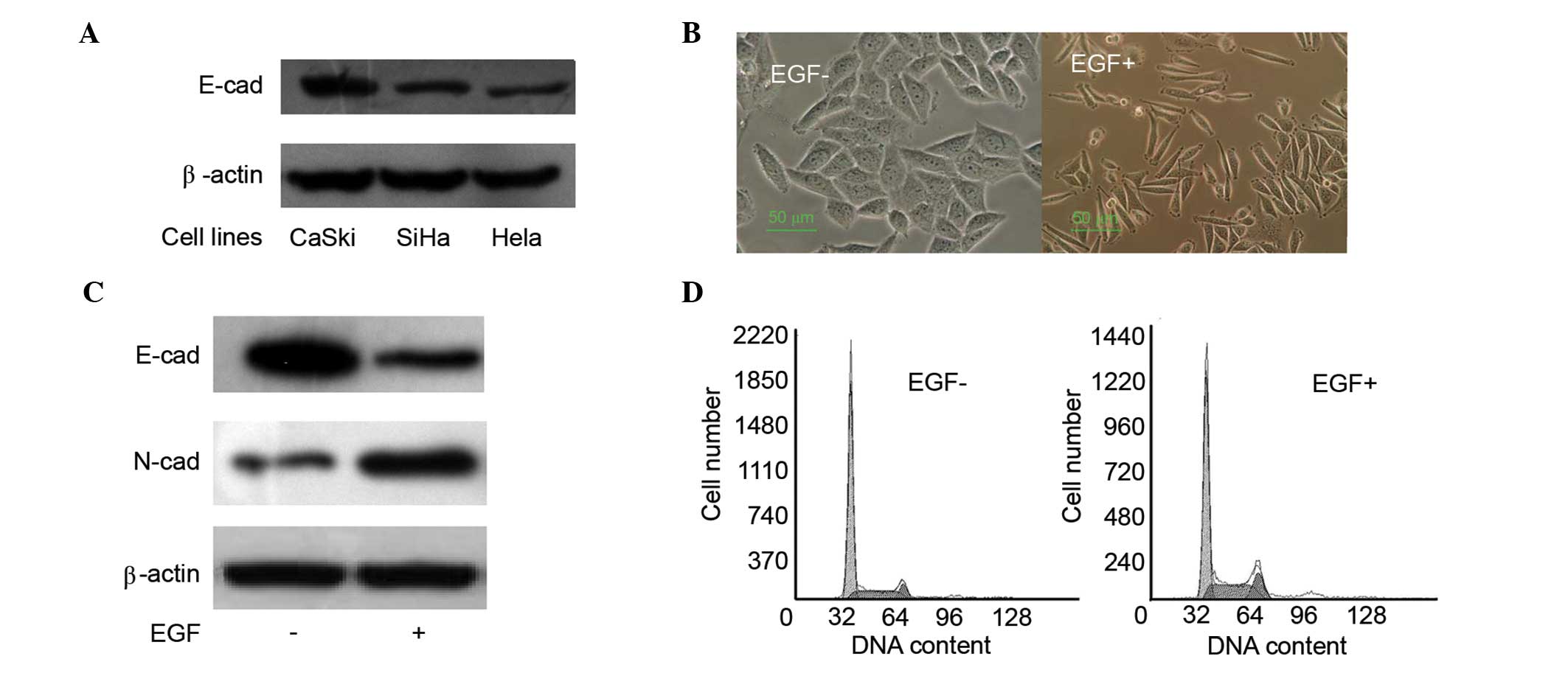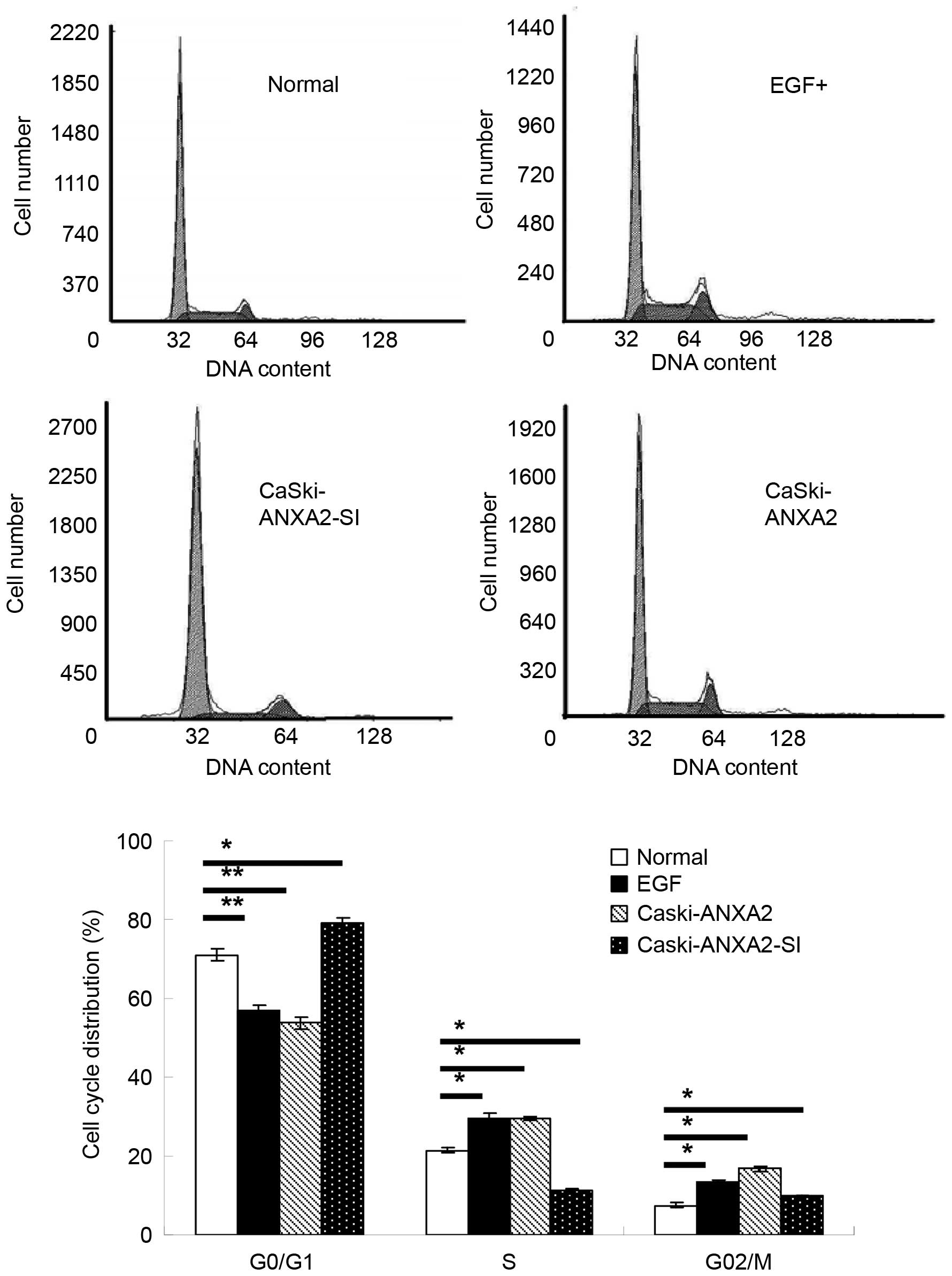|
1
|
Mathur SP, Mathur RS and Young RC:
Cervical epidermal growth factor-receptor (EGF-R) and serum
insulin-like growth factor II (IGF-II) levels are potential markers
for cervical cancer. Am J Reprod Immunol. 44:222–230. 2000.
View Article : Google Scholar : PubMed/NCBI
|
|
2
|
Kim GE, Kim YB, Cho NH, Chung HC, Pyo HR,
Lee JD, Park TK, Koom WS, Chun M and Suh CO: Synchronous
coexpression of epidermal growth factor receptor and
cyclooxygenase-2 in carcinomas of the uterine cervix: A potential
predictor of poor survival. Clin Cancer Res. 10:1366–1374. 2004.
View Article : Google Scholar : PubMed/NCBI
|
|
3
|
Oh MJ, Choi JH, Kim IH, Lee YH, Huh JY,
Park YK, Lee KW, Chough SY, Joo KS, Ku BS and Saw HS: Detection of
epidermal growth factor receptor in the serum of patients with
cervical carcinoma. Clin Cancer Res. 6:4760–4763. 2000.PubMed/NCBI
|
|
4
|
Lee MY, Chou CY, Tang MJ and Shen MR:
Epithelial-mesenchymal transition in cervical cancer: Correlation
with tumor progression, epidermal growth factor receptor
overexpression, and snail up-regulation. Clin Cancer Res.
14:4743–4750. 2008. View Article : Google Scholar : PubMed/NCBI
|
|
5
|
Yoshida K, Yoshida S, Choisunirachon N,
Saito T, Matsumoto K, Saeki K, Mochizuki M, Nishimura R, Sasaki N
and Nakagawa T: The relationship between clinicopathological
features and expression of epithelial and mesenchymal markers in
spontaneous canine mammary gland tumors. J Vet Med Sci.
76:1321–1327. 2014. View Article : Google Scholar : PubMed/NCBI
|
|
6
|
Gerke V and Moss SE: Annexins: From
structure to function. Physiol Rev. 82:331–371. 2002. View Article : Google Scholar : PubMed/NCBI
|
|
7
|
Flood EC and Hajjar KA: The annexin A2
system and vascular homeostasis. Vascul Pharmacol. 54:59–67. 2011.
View Article : Google Scholar : PubMed/NCBI
|
|
8
|
Brichory FM, Misek DE, Yim AM, Krause MC,
Giordano TJ, Beer DG and Hanash SM: An immune response manifested
by the common occurrence of annexins I and II autoantibodies and
high circulating levels of IL-6 in lung cancer. Proc Natl Acad Sci
USA. 98:9824–9829. 2001. View Article : Google Scholar : PubMed/NCBI
|
|
9
|
Keutzer JC and Hirschhorn RR: The
growth-regulated gene 1B6 is identified as the heavy chain of
calpactin I. Exp Cell Res. 188:153–159. 1990. View Article : Google Scholar : PubMed/NCBI
|
|
10
|
Sharma MR, Koltowski L, Ownbey RT,
Tuszynski GP and Sharma MC: Angiogenesis-associated protein annexin
II in breast cancer: Selective expression in invasive breast cancer
and contribution to tumor invasion and progression. Exp Mol Pathol.
81:146–156. 2006. View Article : Google Scholar : PubMed/NCBI
|
|
11
|
Sharma MR, Rothman V, Tuszynski GP and
Sharma MC: Antibody-directed targeting of angiostatin's receptor
annexin II inhibits Lewis lung carcinoma tumor growth via blocking
of plasminogen activation: Possible biochemical mechanism of
angiostatin's action. Exp Mol Pathol. 81:136–145. 2006. View Article : Google Scholar : PubMed/NCBI
|
|
12
|
Hwang J, Hodis HN, Hsiai TK, Asatryan L
and Sevanian A: Role of annexin II in estrogen-induced macrophage
matrix metalloproteinase-9 activity: The modulating effect of
statins. Atherosclerosis. 189:76–82. 2006. View Article : Google Scholar : PubMed/NCBI
|
|
13
|
Brownstein C, Deora AB, Jacovina AT,
Weintraub R, Gertler M, Khan KM, Falcone DJ and Hajjar KA: Annexin
II mediates plasminogen-dependent matrix invasion by human
monocytes: Enhanced expression by macrophages. Blood. 103:317–324.
2004. View Article : Google Scholar : PubMed/NCBI
|
|
14
|
Zhao P, Zhang W, Tang J, Ma XK, Dai JY, Li
Y, Jiang JL, Zhang SH and Chen ZN: Annexin II promotes invasion and
migration of human hepatocellular carcinoma cells in vitro via its
interaction with HAb18G/CD147. Cancer Sci. 101:387–395. 2010.
View Article : Google Scholar : PubMed/NCBI
|
|
15
|
Sharma M, Ownbey RT and Sharma MC: Breast
cancer cell surface annexin II induces cell migration and
neoangiogenesis via tPA dependent plasmin generation. Exp Mol
Pathol. 88:278–286. 2010. View Article : Google Scholar : PubMed/NCBI
|
|
16
|
Ohno Y, Izumi M, Kawamura T, Nishimura T,
Mukai K and Tachibana M: Annexin II represents metastatic potential
in clear-cell renal cell carcinoma. Br J Cancer. 101:287–294. 2009.
View Article : Google Scholar : PubMed/NCBI
|
|
17
|
Lokman NA, Ween MP, Oehler MK and
Ricciardelli C: The role of annexin A2 in tumorigenesis and cancer
progression. Cancer Microenviron. 4:199–208. 2011. View Article : Google Scholar : PubMed/NCBI
|
|
18
|
Serrano MJ, Ortega FG, Alvarez-Cubero MJ,
Nadal R, Sanchez-Rovira P, Salido M, Rodríguez M, García-Puche JL,
Delgado-Rodriguez M, Solé F, et al: EMT and EGFR in CTCs
cytokeratin negative non-metastatic breast cancer. Oncotarget.
5:7486–7497. 2014. View Article : Google Scholar : PubMed/NCBI
|
|
19
|
Bhat FA, Sharmila G, Balakrishnan S,
Arunkumar R, Elumalai P, Suganya S, Singh P Raja, Srinivasan N and
Arunakaran J: Quercetin reverses EGF-induced epithelial to
mesenchymal transition and invasiveness in prostate cancer (PC-3)
cell line via EGFR/PI3K/Akt pathway. J Nutr Biochem. 25:1132–1139.
2014. View Article : Google Scholar : PubMed/NCBI
|
|
20
|
Zheng L, Foley K, Huang L, Leubner A, Mo
G, Olino K, Edil BH, Mizuma M, Sharma R, Le DT, et al: Tyrosine 23
phosphorylation-dependent cell-surface localization of annexin A2
is required for invasion and metastases of pancreatic cancer. PLoS
One. 6:e193902011. View Article : Google Scholar : PubMed/NCBI
|
|
21
|
Lei C, Wang Y, Huang Y, Yu H, Huang Y, Wu
L and Huang L: Up-regulated miR155 reverses the
epithelial-mesenchymal transition induced by EGF and increases
chemo-sensitivity to cisplatin in human Caski cervical cancer
cells. PLoS One. 7:e523102012. View Article : Google Scholar : PubMed/NCBI
|
|
22
|
Huber MA, Kraut N and Beug H: Molecular
requirements for epithelial-mesenchymal transition during tumor
progression. Curr Opin Cell Biol. 17:548–558. 2005. View Article : Google Scholar : PubMed/NCBI
|
|
23
|
Mimeault M and Batra SK: Interplay of
distinct growth factors during epithelial mesenchymal transition of
cancer progenitor cells and molecular targeting as novel cancer
therapies. Ann Oncol. 18:1605–1619. 2007. View Article : Google Scholar : PubMed/NCBI
|
|
24
|
Kersemaekers AM, Fleuren GJ, Kenter GG,
Van den Broek LJ, Uljee SM, Hermans J and Van de Vijver MJ:
Oncogene alterations in carcinomas of the uterine cervix:
Overexpression of the epidermal growth factor receptor is
associated with poor prognosis. Clin Cancer Res. 5:577–586.
1999.PubMed/NCBI
|
|
25
|
Noordhuis MG, Eijsink JJ, Ten Hoor KA,
Roossink F, Hollema H, Arts HJ, Pras E, Maduro JH, Reyners AK, de
Bock GH, et al: Expression of epidermal growth factor receptor
(EGFR) and activated EGFR predict poor response to (chemo)
radiation and survival in cervical cancer. Clin Cancer Res.
15:7389–7397. 2009. View Article : Google Scholar : PubMed/NCBI
|
|
26
|
Grewal T and Enrich C: Annexins-modulators
of EGF receptor signalling and trafficking. Cell Signal.
21:847–858. 2009. View Article : Google Scholar : PubMed/NCBI
|
|
27
|
de Graauw M, Cao L, Winkel L, van
Miltenburg MH, le Dévedéc SE, Klop M, Yan K, Pont C, Rogkoti VM,
Tijsma A, et al: Annexin A2 depletion delays EGFR endocytic
trafficking via cofilin activation and enhances EGFR signaling and
metastasis formation. Oncogene. 33:2610–2619. 2014. View Article : Google Scholar : PubMed/NCBI
|
|
28
|
Cha YH, Kim NH, Park C, Lee I, Kim HS and
Yook JI: MiRNA-34 intrinsically links p53 tumor suppressor and Wnt
signaling. Cell Cycle. 11:1273–1281. 2012. View Article : Google Scholar : PubMed/NCBI
|
|
29
|
Zhou S, Yi T, Liu R, Bian C, Qi X, He X,
Wang K, Li J, Zhao X, Huang C and Wei Y: Proteomics identification
of annexin A2 as a key mediator in the metastasis and
proangiogenesis of endometrial cells in human adenomyosis. Mol Cell
Proteomics. 11:M1122012. View Article : Google Scholar : PubMed/NCBI
|
|
30
|
Yim EK, Tong SY, Ho EM, Bae JH, Um SJ and
Park JS: Anticancer effects on TACC3 by treatment of paclitaxel in
HPV-18 positive cervical carcinoma cells. Oncol Rep. 21:549–557.
2009.PubMed/NCBI
|
|
31
|
Andey T, Marepally S, Patel A, Jackson T,
Sarkar S, O'Connell M, Reddy RC, Chellappan S, Singh P and Singh M:
Cationic lipid guided short-hairpin RNA interference of annexin A2
attenuates tumor growth and metastasis in a mouse lung cancer stem
cell model. J Control Release. 184:67–78. 2014. View Article : Google Scholar : PubMed/NCBI
|














